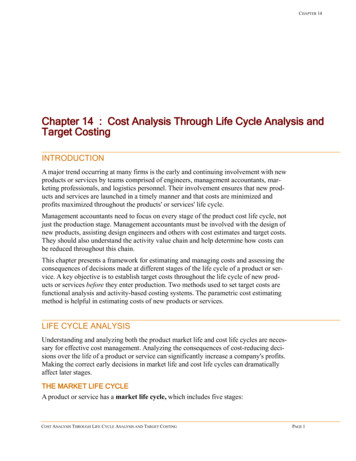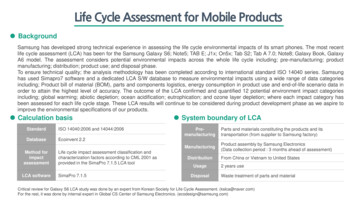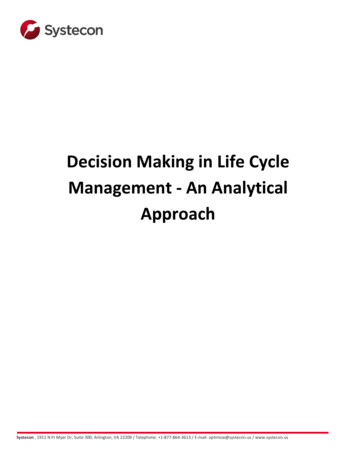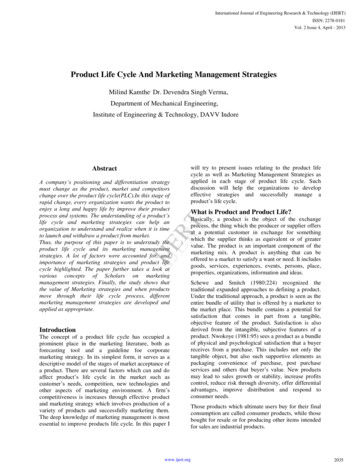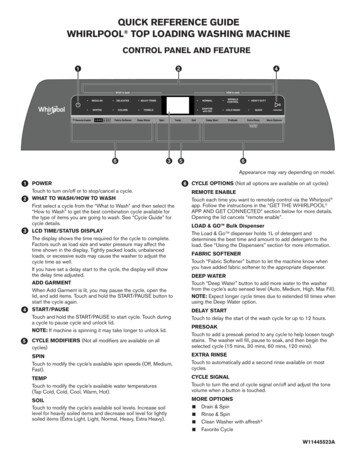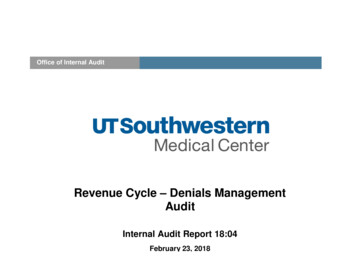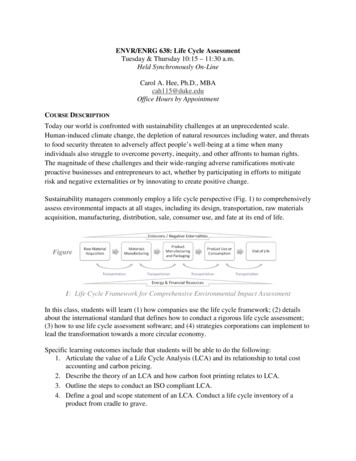
Transcription
ENVR/ENRG 638: Life Cycle AssessmentTuesday & Thursday 10:15 – 11:30 a.m.Held Synchronously On-LineCarol A. Hee, Ph.D., MBAcah115@duke.eduOffice Hours by AppointmentCOURSE DESCRIPTIONToday our world is confronted with sustainability challenges at an unprecedented scale.Human-induced climate change, the depletion of natural resources including water, and threatsto food security threaten to adversely affect people’s well-being at a time when manyindividuals also struggle to overcome poverty, inequity, and other affronts to human rights.The magnitude of these challenges and their wide-ranging adverse ramifications motivateproactive businesses and entrepreneurs to act, whether by participating in efforts to mitigaterisk and negative externalities or by innovating to create positive change.Sustainability managers commonly employ a life cycle perspective (Fig. 1) to comprehensivelyassess environmental impacts at all stages, including its design, transportation, raw materialsacquisition, manufacturing, distribution, sale, consumer use, and fate at its end of life.Figure1: Life Cycle Framework for Comprehensive Environmental Impact AssessmentIn this class, students will learn (1) how companies use the life cycle framework; (2) detailsabout the international standard that defines how to conduct a rigorous life cycle assessment;(3) how to use life cycle assessment software; and (4) strategies corporations can implement tolead the transformation towards a more circular economy.Specific learning outcomes include that students will be able to do the following:1. Articulate the value of a Life Cycle Analysis (LCA) and its relationship to total costaccounting and carbon pricing.2. Describe the theory of an LCA and how carbon foot printing relates to LCA.3. Outline the steps to conduct an ISO compliant LCA.4. Define a goal and scope statement of an LCA. Conduct a life cycle inventory of aproduct from cradle to grave.
5. Describe common environmental impacts associated with a life cycle inventory ofprocesses.6. Conduct a screening-level and ISO compliant life cycle assessment with LCAsoftware.7. Conduct a consequential LCA. Interpret, critique, and communicate LCA results.Important Matters Needing to be Addressed Up Front1. Basic Needs and TechnologyAny student who faces challenges securing their food or housing and believes this may affect theirperformance in the course is urged to contact the Dean of Students for support. Furthermore, pleasenotify me if you are comfortable in doing so. This will enable me to provide any resources that Imay possess.Any student who faces challenges accessing course material and/or attending synchronous classsessions on-line due to technology issues should bring this to my attention. Accommodations canbe made so that your participation and other grades do not suffer as a result of issues beyond yourcontrol. The most important thing you can do if/when you face technology issues is tocommunicate these to me as soon as possible. If you know in advance that internet connectivitywill likely be a challenge, please communicate this at the start of the semester.2. Solidarity and Anti-RacismI, Professor Carol Hee, respect the inherent dignity of all people, especially my students, and knowthat long-standing and ever-present issues of systemic racism, anti-LGBTQ sentiment, and otherforms of exclusion and injustice cause harm to many and all-to-often go unacknowledged. I haveundergone unconscious bias training and am actively educating myself about how I can best be antiracist and an ally to the marginalized. I endorse the Nicholas School’s commitment to diversity,equity, and inclusion inclusion). As an educator, Iknow that one of the most useful things I can do to support equity is to utilize the pedagogicalmethods known as “Inclusive Teaching.” I remain open to learning and making changes, sostudents are welcome to discuss their ideas and concerns with me.In accord with Title IX, Duke prohibits discrimination and harassment based on any protectedstatus—i.e., race, religion, gender, ethnicity. Discriminatory or harassing behavior will not betolerated in this class. If a student is experiencing harassment, they should feel welcome to discussthis problem with Professor Hee who is willing to serve as an advocate on their behalf.Duke University exists on land that was originally the territory of several Native nations, includingthe Shakori, Catawba, and Eno peoples and, to a large extent, was built by slave labor. One (1) wayto give honor to those who suffered injustices related to the creation of our university is for you tomake the most of your education—to be the best student you can be, as I will strive to be the bestteacher I can be, and to use what you learn at Duke to make the world a better place. In the wordsof Peter Parker’s uncle “With great power, comes great responsibility.” The goal that drives me toteach this course is to empower you with knowledge, insight, and confidence that will empower youto drive change. Being a student at Duke is a privilege that comes with responsibility.
3. Physical and Mental HealthGiven that we are living through a pandemic, special attention must be given to physical and mentalhealth. The website Updates for Students - Coronavirus Response (duke.edu) has information youmay find useful. If you feel sick, visit https://coronavirus.duke.edu/if-you-feel-sick/ for guidance.Many of my past students have benefited from counselling through University Health Services. Iwas a beneficiary of this support while a graduate student at UNC in the late 1990s and remain astrong supporter of having professional support for one’s mental health in the same way peoplehave a primary care physician for their physical health. You may find helpful support starting athttps://coronavirus.duke.edu/support/.If your health or concern about the health and well-being of a loved one is getting in the way of youdoing your best work in this class, please communicate this to me and do so sooner rather thanlater. Across the 14 years I have taught graduate and undergraduate students, I have worked withmany students to devise plans that prevent their grades from being affected by physical and mentalhealth issues. Please do not wait until the end of the semester or after grades are submitted to tellme that you deserve a break because of a hardship. At that point it will be too late. Instead, ownyour power and advocate for yourself. I am one of many who stand ready to do what we can tohelp.ADDITIONAL INFORMATION ABOUT THIS COURSECOURSE MATERIALSRequired Software: You must purchase a student license for Sustainable Minds at this d. ( 49)Required Textbook: Environmental Life Cycle Assessment. Olivier Jolliet, Myriam SaadeSbeih, et al. CRC Press. ISBN-13: 978-1439887660. Download as a FREE e-book or purchasea hardcopy with prices starting at 67 on Amazon. 07S2SSGQF/ref mt other? encoding UTF8&me &qid Additional Readings: Posted on Sakai and linked to through this syllabus.OPTIONAL Textbook: Life Cycle Assessment: Quantitative Approaches for Decisions ThatMatter. Scott Matthews, Chris T. Hendrickson, and Deanna H. Matthews (Link)ATTENDANCE AND PARTICIPATIONParticipation in this course is defined as a combination of attendance and contributions to classdiscussions.Attendance (10%)Living in the Time of COVID presents unprecedented challenges. I understand that you maynot be able to make every class, whether that’s due to technology issues or personal issues.Nevertheless, you should make every effort to attend class IF you are healthy. If you are unable
to join class for whatever reason, please do the professional and courteous thing and send me anemail before class. If your internet connection drops you from the class or you need to leave toattend to an emergency, send me an email after class. If you have more than two unexcusedabsences, your participation grade will decrease. If you do not communicate with me to tell meyou will miss class, your attendance grade will be decreased.“Being a Beneficial Presence” (10%)This class is designed as a synchronous course in order to enable real-time discussion. Active,participation is expected. By actively participating in discussion, you will be a “beneficialpresence”: you, your peers, and your professor will all learn more.Please remember: (1) quality is more important than quantity and (2) silence is not a reliableindicator of preparation or thoughtfulness. Excellent comments possess one or more of thefollowing attributes: (1) they offer an original and relevant perspective on the issue, (2) theymove the analysis forward by building on previous contributions or by revealing fresh insights,(3) they transcend the “I feel” syndrome by including evidence that is based on more thanpersonal experience — in other words, your thinking should reflect and integrate examples fromother contexts. Please do not hesitate to ask for clarification or for something to be repeatedwhen you need it; chances are several others are in the same position as you.If you are not comfortable volunteering to participate, taking this class will provide you with theopportunity to gain experience and confidence doing so. It is important for your long-termcareer success to practice speaking up as a way to demonstrate that you are a beneficialpresence. I encourage participation from all students, but the burden of participating remainswith you. One recommendation is to prepare in advance one point or one question you wouldlike to contribute; another is to set a personal goal of volunteering to make contribution at leastonce a week.Students who do not participate in discussions and are only silent observers will earn amaximum participation grade of 7.5/10. Students with 2 excused absences or a lack of timelycommunication will earn a maximum attendance grade of 7.5/10.ASSIGNMENTSAll completed assignments should be uploaded to Sakai through the “Assignments” section.Late assignments will be accepted up to 1 week after their due date with a penalty. After 1week, late assignments will not be accepted.NB: Unless specified otherwise, papers should be submitted in MS Word (not as a PDF) andformatted with 1 in margins, 1.5 or double spaced, in left-justified Times New Roman 12-pointfont. These directions may seem like micromanaging, but research shows font style anddocument formatting can influence a reader’s perception of the quality of a document’s content.If all students submit their work in the same format, this potential source of bias will beremoved.1—HWs from LCA Textbook (10% total) INDIVIDUALoExercise 2.2 at end of Ch 2, due Sunday, February 21, 11:59 pm.oExercise 3.2 in our Textbook, due Sunday, February 28, 11:59 pm.
2—Carbon Pricing Brief (15%) INDIVIDUALDue Sunday, January 31st, 11:59pm.a) Select a publicly traded company (other than Apple) that publishes its carbon emissionsdata.b) From the company’s 10k and emissions data, create an Excel spreadsheet that contains 5years of data for net income (i.e., profits). Include a note of the source of this data.c) From the company’s sustainability report or website, add carbon emissions data for thepast 5 years to your spreadsheet, broken down into as many subcategories as provided.Include a note of the source of this data.d) Calculate the effect of a carbon price on the company’s profits for the following scenarios:i.The current average price used by corporates: 10ii.The min and max amount environmental economists think is required to drivetransformational change ( 40- 80)iii.What % of total profits are these carbon costs?iv.Is this cost high or low? To answer this question, you will need to think criticallyabout how to best put this number into context. I included two points forcomparison: R&D expenses and CEO salary. You may use these two, but youneed to include at least 3 other methods of assessing whether the carbon cost ishigh or low. You must not only do the calculation; in your brief, you must alsoinclude commentary on whether these calculations demonstrate that the cost ishigh or low.e) Write a 2-page brief to the company’s CFO making the case based on the quantitativeinformation you just compiled as to whether you believe the company should implementan internal carbon price.NB: An example spreadsheet for Apple is available on our Sakai site in the description forthis assignment. Do not chose Apple as your company. I recommend you select a companyinformed by your career preferences.3—Quiz on Carbon Footprinting Standard (5%) INDIVIDUALDue Sunday, February 14th, 11:55pm.See Sakai.4—Review of a Published LCA (5%) INDIVIDUALDue Wednesday, February 17th, 11:55pmThis assignment aims to familiarize students with professionally conducted life cycle analysesthat have been published in peer-reviewed literature.a) Students should find and read an LCA published in the International Journal of Life CycleAssessment or the Journal of Cleaner Production. Duke’s e-libraryb) Fill out the information specified on the following Google Sheet. (Students should referencethis sheet to ensure there are no duplicates.)
NB:oYou should select an LCA that is relevant to your specific career interests. Forexample, if you are interested in working in the fashion industry on sustainabletextiles, you may want to find an LCA that compares two different types of fabricsuch as cotton versus bamboo.oYou may not understand all of the details in the paper; that is OK; by the end of thecourse, you will.oYou may ask “Why are we reading an academic LCA when we will never writesomething like this?” The reason is that although you may not author a paper likethis, if you do conduct an LCA, you will need to record all of the same details. Thiswill be true whether you present the information in the form of a paper published in ajournal or in a Power Point presentation to a client. Additionally, you may need torely on such papers to answer LCA-related questions or to provide insights beforestarting your own LCA. You will be able to save time, money, and effort knowingwhere to find and how to understand published LCAs. Finally, LCAs conducted bybrands are normally proprietary or part of publicly inaccessible databases.5—Screening-Level LCA using Sustainable Minds (20%) TEAMDue Sunday, March 14, 11:59pm.oA natural health and beauty company wants to know which packaging option they shoulduse for a new deodorant they wish to market as exceptionally “green.”oUse Sustainable Minds to compare four packaging options using the data provided viaSakai.oCreate a PowerPoint presentation that describes your work, results, and yourrecommendations.6—GaBi Assignments (3 x 10%) INDIVIDUALDue dates will be announced when the HW is assigned. Timing will depend on the amount ofmaterial covered during each class. See Sakai.GRADING SCHEMERaw scores will be converted to percentages. Percentages will be converted using this table:94.090.087.083.080.077.0 AAB BBC 10093.989.986.982.979.973.070.067.063.060.00 CCD DDF 76.972.969.966.96360
Pass/Fail OptionAs stated on the Nicholas School web site: “Letter grades will be the default grading option forMEM and MF students spring semester 2021. Recognizing that COVID-19, the economic crisis,significant changes in course delivery, concerns about equity, and the U.S. election will combine toincrease student stress over the coming months, the Nicholas School will allow its professionalstudents to request Pass-Fail (P/F) grade in one or more classes this semester.”In accord with school guidance, I am setting the threshold to receive a “Pass” at 69.9 in this class.Note the school’s language regarding this cut-off: “Instructors will need to define explicit criteriafor a Passing grade and may set this threshold high. ”How?Students must make their request in writing to the instructor of each class for which they arerequesting a change in grading basis.Timing?Students must make their P/F request by mid-semester (Friday, March 5, 2021) for fullsemester classes, or by the end of the third week of half-semester courses. Instructors willonly consider requests after this deadline in the event of personal emergencies, includingsignificant health crises and family concerns.For more information, please visit LINK.ACADEMIC INTEGRITYAll activities of Nicholas School students, including those in this course, are governed by theDuke Community Standard, which states:Duke University is a community dedicated to scholarship, leadership, and service and tothe principles of honesty, fairness, respect, and accountability. Citizens of thiscommunity commit to reflect upon and uphold these principles in all academic andnonacademic endeavors, and to protect and promote a culture of integrity. To upholdthe Duke Community Standard: I will not lie, cheat, or steal in my academic endeavors; I will conduct myself honorably in all my endeavors; and I will act if the Standard is compromised.During COVID times, additional community standards are in effect and must be followed bystudents in this class as detailed at https://returnto.duke.edu/the-duke-compact/.
COURSE SCHEDULEThe instructor reserves the right to adapt the course schedule as necessary throughout the semester.Students are responsible to stay abreast of any changes through Sakai. If a link is broken, try to findthe resource listed by google-ing the name of the reading before emailing Prof. Hee.1. Thursday, January 21Topic: Introductions, course details, and plansAssignments:a) Review course syllabus and come to class with any questions you haveb) Complete the draft of your personal page in the slide deck available at:c) NOTE: There is A LOT of reading assigned for class on Feb 2. You would be wise to geta head-start on this reading NOW instead of waiting in case you are not “in the mood” todo all of the reading on Feb 1.2. Tuesday, January 26Topic: Assessing Life Cycle Impacts at the Individual ScaleAssignments:oCalculate your own carbon footprint using the calculator te.php. Record your data so you canshare your numbers with the class! Make note of what components contributed the most.oRead “Food Miles or Poverty Eradication? The Moral Duty to Eat African Strawberriesat Christmas.” (Link)3. Thursday, January 28Topic: Strategic Sustainability Uses of Life-Cycle AnalysisRead:o“Strategic Sustainability Uses of Life-Cycle Analysis” by Gregory Unruh. MIT SloanManagement Review. September 22, 2015. (Link)o“PUMA: Leading the Pack with an Environmental Profit and Loss Statement” by CarolHee and Nikita Uday Godbole. UNC Kenan-Flagler Business School. Fall 2014. (Link)4. Tuesday, February 2Topic: LCA and LCC: Tools for Quantifying Environmental ExternalitiesRead:
oPages 1-15. “An Introduction to Environmental Accounting as a Business ManagementTool” by EPA. Office of Pollution Prevention and Toxics. June 1995. (Link)o1-page website “Total Cost Assessment Methodology” (Link). Note that this site containsa link to the full report (Link) which you may want to download as a useful reference!5. Thursday, February 46. Tuesday, February 97. Thursday, February 11Part A - Individual Meetings and Three Asynchronous Training Sessions on CarbonFootprintingoMeetings: A 15-min time slot to meet with Professor Hee via Zoom.Part B - The Greenhouse Gas Protocol’s Corporate Standard 3-Part training webinarInstructions:1. Access the 3-Part training by clicking on the “GoToStage channel” link in the finalparagraph on the page: : go2. NOTE: Each session is approximately 1 ¼ hrs and will serve as a substitute for meetingduring our regular class time.3. Edit your resume to include the fact that you completed WRI’s 3-part training on theGreenhouse Gas Protocol’s Corporate Standard.8. Tuesday, February 16Topic: Overview of the ISO LCA StandardRead: Textbook Chapter 2: General Principles of Life Cycle AssessmentAssignments:oComplete Q2 at end of Ch 2. Upload answer in Word doc to Sakai before class.oPay for your student subscription to Sustainable Minds if you have not done so already:http://www.sustainableminds.com/ ( 49)9. Thursday, February 18Topic: Examples of Published LCAsAssignment:oSee description of HW required in advance of today’s class above in “Assignments” section.
10. Tuesday, February 23Topic: The ISO LCA Standard – Step 1a: Goal and ScopeRead: Chapter 3, Section 3.1 and 3.2.11. Thursday, February 25Topic: The ISO LCA Standard – Step 1b: Defining the Functional Unit and Setting BoundariesAssignments:oRead Chapter 3, Sections 3.3, 3.4, and 3.5oWatch1) “Overview & Tour of Sustainable Minds”: https://youtu.be/z aCvUc-YjA (2:30)2) “Sustainable Minds LCA Demo”: https://youtu.be/hzKN5Tb4W7U (9:47)oSolve Exercise 3.2 in our Textbook and upload your work to Sakai by 11:59 pm Sunday,February 28.12. Tuesday, March 2Topic: ISO LCA Standard – Step 2: Inventory Analysis, Introduction to Data Acquisition andManagement for LCA InventoryAssignments:oRead Chapter 5 from “Free LCAText” on LCA Sakai13. Thursday, March 4Topic: ISO LCA Standard – Step 2: Inventory Analysis and Sustainable Minds Project Intro.Assignments:oRead Ch 4: 4.1, 4.2, and 4.3 in our class textbookoComplete a screening-level LCA using Sustainable Minds following the instructionsprovided on Sakai. Due Sunday, March 14, 11:59pm. (Team project)00. Tuesday, March 9Wellness Day – No class!14. Thursday, March 11Topic: ISO Step 3 and 4: Impact Assessment and InterpretationRead:oChapter 6, sections 6.1, 6.2, 6.3, and 6.4 in our textbook15-22. For Four Weeks (Wks 9-12): Using GaBi to Conduct a Detailed LCA
Assignments:oFor Thursday, March 16, watch “LCA Software GaBi in 5 Minutes”:https://www.youtube.com/watch?v ETWsM4RReRc&t 53soThroughout these four weeks, you will complete three small assignments using GaBi thatwill build your comfort using this complex software. Details will be provided on Sakai.oTo prepare for class, you should1) Review materials covered the prior day by replicating the work in GaBi that wedid together as a class.2) Using what we did in class as a model, create your own GaBi project that you canbuild on and alter as we cover new material.At the end of this section, you should update your resume to include that you havebeginner- or intermediate-level proficiency using GaBi.o23. Tuesday, April 13Topic: Circularity and Net Positive – Part IAssignments:1. Watch:o“Navigating the Circular Economy: A Conversation with Dame Ellen ion-with-dameellen-macarthur (4:28)oOptional but awesome! Bill McDonough’s TED Talk athttps://www.ted.com/talks/william mcdonough on cradle to cradle design?language en2. Read:o“Towards a Circular Economy: Business Rationale for an Accelerated Transition” by theEllen MacArthur Foundation and McKinsey Consulting. November 2015. (Link)o“Eight Companies to Watch in the Circular Economy” GreenBiz. August 10, watch-circular-economy.3. Consider the following questions:oWhat examples of circularity are you personally familiar with?oEnvironmentalists are sometimes criticized for being “anti-growth”? What argumentdoes McDonough make that addresses the question of whether growth is good?oWhat do you believe are the largest impediments to a circular economy?oWhat product or business types do you think most need to become more circular? Forwhich would the change be easiest? hardest? most popular with consumers?
24. Thursday, April 15Topic: Circularity and Net Positive – Part IIAssignments:oRead: this article it is on the long side, but trust me, it’s worth it:a) “Net Positive: The Future of Sustainable Business” by Jeffrey Hollender. StanfordSocial Innovation Review. April 29, 2015. (Link)Watch the following videos:a) Jeffrey Hollender: “Less Bad Does Not Equal Good.” Link (1:58)b) Ray Anderson: Link (5:56)c) NetWorks: Video 1 (8:24), Video 2, (2:10), Video 3 (2:32)d) Weaving a Better Life: Link (3:50)o25. Tuesday, April 20Topic: Socially-focused Life Cycle Assessments (SLCA)Read:oExecutive Summary, Introduction (Ch1), and What is Social Life Cycle Assessment(Ch2) in Guidelines for Social Life Cycle Assessment of Products and Organizations.2020. (Link)26. Thursday, April 22Topic: LDOC – Course Wrap UP
1. Articulate the value of a Life Cycle Analysis (LCA) and its relationship to total cost accounting and carbon pricing. 2. Describe the theory of an LCA and how carbon foot printing relates to LCA. 3. Outline the steps to conduct an ISO compliant LCA. 4. Define a goal and scope statement of an LCA. Conduct a life cycle inventory of a

